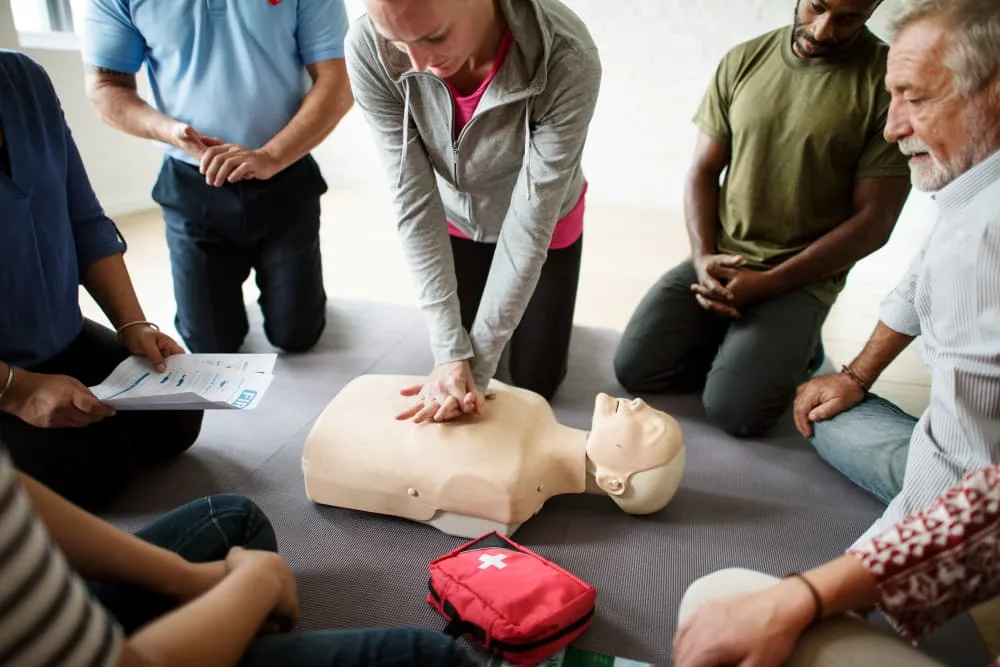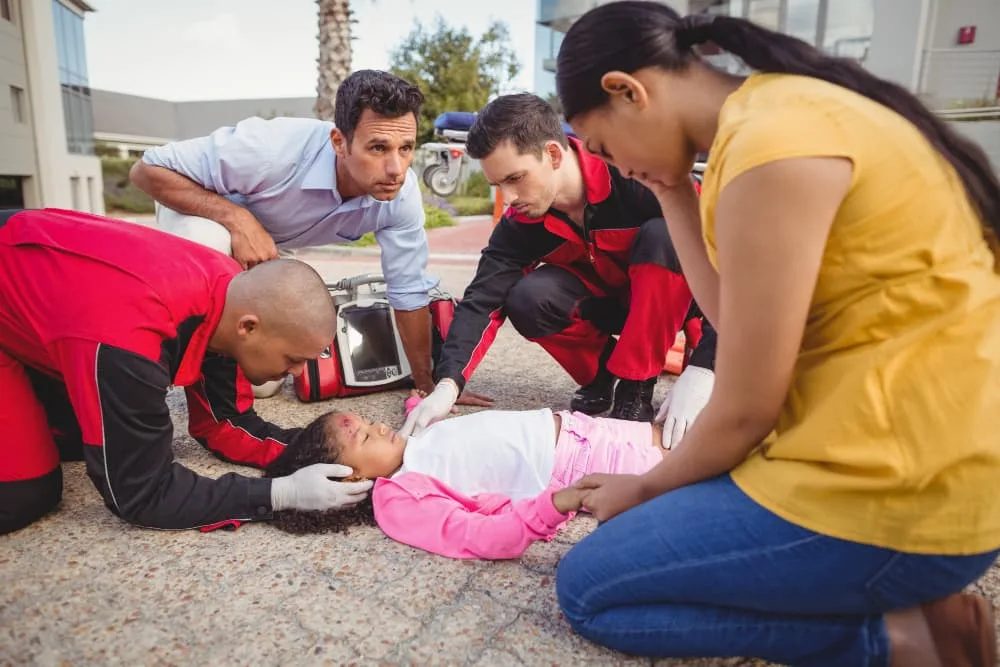Introduction: First Aid Training
In our fast-paced world, where unforeseen accidents can occur at any moment, possessing comprehensive first aid skills is not just beneficial; it is an absolute necessity. This extensive guide aims to take you through every critical aspect of first aid training, ensuring that you are well-equipped to handle a wide range of emergencies.
Understanding the Fundamentals: First Aid Training
Defining First Aid
First aid involves providing immediate assistance to someone suffering from an illness or injury, offering initial care until professional help arrives. From minor cuts to severe situations, having a grasp of the fundamentals can make a significant difference.
Legal Implications and Responsibilities
Navigating the legal aspects of administering first aid is crucial. While it varies by jurisdiction, the Good Samaritan Law generally protects those who provide reasonable assistance in an emergency. This guide will help you understand your rights and responsibilities for appropriate action.
Emphasizing Quick Response
Time is of the essence in emergencies. This section underscores the critical importance of a swift response, exploring what to do and how acting promptly can be life-saving, especially in situations like cardiac arrest or choking incidents.
Mastering Essential First Aid Skills
Comprehensive CPR Techniques
Cardiopulmonary resuscitation (CPR) is a fundamental skill that can save lives during cardiac emergencies. Gain a deep understanding of proper techniques, including chest compressions and rescue breaths, and develop the confidence to act decisively in critical situations.
CPR Tips:
● Check Responsiveness: Ensure the person is unresponsive and not breathing normally.
● Call for Help: Dial emergency services immediately before starting CPR.
● Effective Compressions: Use the heel of your hand for chest compressions, pushing hard and fast at a rate of 100-120 compressions per minute.
Adeptly Managing Burns and Scalds
Immediate attention is crucial for burns and scalds to minimize damage and alleviate pain. Delve into this guide to discover the appropriate first aid measures for different degrees of burns, ensuring that you can provide the right care until professional help is available.
Burn Care Techniques:
● Cool Running Water: Run cool (not cold) water over the burn for at least 10 minutes.
● Avoid Ice: Do not use ice on burns, as it can further damage the tissue.
● Cover with a Clean Cloth: Use a non-stick, sterile bandage or clean cloth to cover the burn once cooled.
Expertly Handling Fractures and Sprains
Knowing how to manage fractures and sprains is vital to prevent further injury. This section provides an in-depth, step-by-step guide on assessing and providing initial care for musculoskeletal injuries.
Fracture and Sprain Tips:
● Immobilization: Keep the injured area still to prevent further damage.
● Elevation: Elevate the injured limb to reduce swelling.
● Cold Compress: Apply a cold compress or ice pack to alleviate pain and swelling.
Recognizing Signs of Stroke and Heart Attack
Early identification of stroke and heart attack symptoms is key to initiating the right response. Learn to identify warning signs and understand the immediate actions needed to improve the chances of a positive outcome.
Stroke and Heart Attack Response:
● FAST Method: Face drooping, Arm weakness, Speech difficulty, Time to call emergency services.
● Administer Aspirin: If available and not allergic, provide aspirin to someone showing signs of a heart attack.
Building the Perfect First Aid Kit
Constructing a Comprehensive First Aid Kit
A well-stocked first aid kit is indispensable in any home or workplace. Explore this guide to understand the essential items to include, from bandages and antiseptic wipes to scissors and tweezers. Be prepared for unexpected situations with a meticulously prepared kit.
First Aid Kit Essentials:
● Bandages of Various Sizes: For wound dressing and protection.
● Antiseptic Wipes or Solution: Clean wounds before applying dressings.
● Scissors and Tweezers: Essential tools for cutting tape, gauze, and removing splinters.
Medications and Supplies
In this detailed section, we delve into the medications and supplies that can enhance your first aid kit. From pain relievers to allergy medication, understanding what to include can make a substantial difference in providing effective care.
Medication Tips:
● Check Expiry Dates: Regularly review and replace expired medications.
● Include Personal Medications: If someone has a known medical condition, ensure their specific medications are in the kit.
Regular Checks and Restocking
Maintaining your first aid kit is as vital as having one. Learn the importance of regular checks and restocking to ensure that your supplies are up-to-date and ready for use when needed.
Maintenance Tips:
● Schedule Regular Checks: Set a reminder every three months to inspect and update your first aid kit.
● Rotate Medications: Use a “first in, first out” approach for medications to maintain freshness.
Handling Common Emergency Situations
Swift Response to Choking Incidents
Choking can happen to anyone, anywhere. This part of the guide teaches you how to respond quickly and effectively to help a choking victim, emphasizing the Heimlich maneuver and other life-saving techniques.
Choking Response Techniques:
● Heimlich Maneuver: Stand behind the person, wrap your arms around their waist, and perform quick, upward abdominal thrusts.
● Back Blows: If the Heimlich maneuver is unsuccessful, deliver back blows between the shoulder blades.
Allergic Reactions and Anaphylaxis Management
Allergic reactions can range from mild to severe, with anaphylaxis being a life-threatening condition. Understand how to identify and respond to allergic reactions, including the proper use of an epinephrine auto-injector.
Anaphylaxis Management:
● Administer Epinephrine: If prescribed, use an auto-injector immediately.
● Call Emergency Services: Even after administering epinephrine, seek emergency medical assistance.
Proficiently Managing Bleeding and Wounds
Proper wound care is indispensable to prevent infection and promote healing. Learn how to manage different types of bleeding, from minor cuts to more severe wounds, and gain the skills to provide effective first aid.
Bleeding Control Techniques:
● Apply Direct Pressure: Use a sterile bandage or clean cloth to apply firm pressure to the wound.
● Elevate the Wound: Raise the injured area to reduce blood flow and minimize swelling.
Addressing Unconsciousness and Revival
When someone becomes unconscious, quick and appropriate action is vital. Explore the steps to assess and revive an unconscious person, including the recovery position and calling for emergency assistance.
Unconsciousness Response Steps:
● Check Breathing: Ensure the person is breathing and if not, begin CPR immediately.
● Recovery Position: If breathing but unconscious, place the person in the recovery position.
Special Considerations for Different Demographics
First Aid for Children
Children require unique considerations in first aid. This section covers the basics, from child-friendly CPR techniques to addressing common childhood injuries.
Child-Specific Tips:
● Use Pediatric CPR Guidelines: Follow guidelines for appropriate chest compressions and rescue breaths.
● Child-Proof Your Space: Minimize potential hazards in areas frequented by children.
First Aid for Seniors
As we age, our health needs change. Discover the specialized first aid considerations for seniors, including fall prevention and assistance for common age-related conditions.
Senior-Specific Tips:
● Fall Prevention Strategies: Create a safe environment by removing tripping hazards.
● Understand Medications: Be aware of seniors’ medication regimens and potential interactions.
Advanced First Aid Techniques
AED Usage and Training
Automated External Defibrillators (AEDs) can be life-saving in cardiac emergencies. Familiarize yourself with AED usage and consider training to confidently use this vital device.
AED Usage Tips:
● Follow Voice Prompts: Most AEDs provide voice instructions for ease of use.
● Apply Electrodes Correctly: Proper placement is crucial for effective defibrillation.
Emergency Oxygen Administration
In situations where oxygen levels are compromised, understanding how to administer emergency oxygen can be crucial. This section explores the basics of oxygen administration and when it is necessary.
Oxygen Administration Guidelines:
● Use a Mask or Nasal Cannula: Ensure proper fit and follow guidelines for oxygen flow rates.
● Monitor Oxygen Levels: Regularly assess the patient’s response and adjust oxygen flow as needed.
Legal Obligations and Continuous Learning
Legal Obligations
Understand the legal obligations related to recording and reporting incidents. Explore the importance of adhering to legal requirements to protect yourself from potential liabilities.
Reporting to Authorities
In certain situations, reporting incidents to authorities is necessary. Gain insights into when and how to report incidents, ensuring a comprehensive response and appropriate follow-up.
Continuous Learning and Updates
Staying Informed about First Aid Advancements
First aid practices and techniques evolve over time. Stay informed about the latest advancements through continuous learning and updates to ensure your skills remain current.
Periodic Training Refreshers
Maintaining proficiency in first aid skills requires regular training refreshers. Discover the importance of periodic courses and how they contribute to overall preparedness.
Joining First Aid Communities
Being part of a first aid community provides ongoing support and resources. Explore the benefits of joining local or online communities to share experiences, and insights, and stay connected.
Specialized First Aid Services: Safety Circle
Becoming a First Aid Expert with Safety Circle
As a solution to becoming a proficient first aider, consider enrolling in specialized first aid training services by Safety Circle. These services offer comprehensive training, hands-on experience, and continuous learning opportunities. By joining Safety Circle, you can enhance your skills, stay updated on advancements, and be part of a community dedicated to safety and well-being.
First Aid Tips and Techniques
Swift Response to Common Emergencies
1. Choking Incidents:
● Perform the Heimlich maneuver for adults and children.
● Deliver back blows if the Heimlich maneuver is unsuccessful.
2. Allergic Reactions and Anaphylaxis:
● Administer epinephrine immediately if prescribed.
● Call emergency services even after administering epinephrine.
3. Bleeding and Wounds:
● Apply direct pressure with a sterile bandage for bleeding control.
● Elevate the wounded area to minimize blood flow and swelling.
4. Unconsciousness and Revival:
● Check breathing and initiate CPR if the person is not breathing.
● Use the recovery position for unconscious individuals who are breathing.
Special Considerations for Different Demographics
1. First Aid for Children:
● Follow pediatric CPR guidelines for chest compressions and rescue breaths.
● Child-proof spaces to minimize potential hazards.
2. First Aid for Seniors:
● Implement fall prevention strategies by removing tripping hazards.
● Understand seniors’ medication regimens and potential interactions.
Advanced First Aid Techniques
1. AED Usage and Training:
● Follow voice prompts provided by AEDs for proper use.
● Ensure electrodes are applied correctly for effective defibrillation.
2. Emergency Oxygen Administration:
● Use a mask or nasal cannula with proper fit and oxygen flow rates.
● Monitor patient response and adjust oxygen levels as needed.
Conclusion
As we conclude this extensive guide, it is clear that effective first aid goes beyond basic skills. From mastering CPR techniques to handling burns, fractures, and advanced situations, continuous learning is the key to being a confident and proficient first aider. By staying informed, joining communities, and considering specialized services like Safety Circle, you can enhance your capabilities and make a significant impact in emergencies.
FAQs
Addressing Common Questions about First Aid
1. What should be included in a basic first aid kit?
Bandages, antiseptic wipes, scissors, tweezers, pain relievers, and allergy medication.
2. How often should I check and restock my first aid kit?
Regular checks every three months based on expiration dates and usage.
3. What is the recovery position, and when should it be used?
A safe way to position an unconscious person; use when there is no suspicion of neck or spine injury.
4. When should a tourniquet be applied?
In situations of severe bleeding where direct pressure is insufficient.
5. How can I stay calm under pressure during emergencies?
Practice stress management techniques and focus on training.
6. Is psychological first aid essential in emergencies?
Yes, recognizing emotional distress is crucial for overall well-being.
Additional Resources for Further Information
Explore our services to enhance your first-aid knowledge and skills. Remember, continuous learning is key to being an effective first aider.


